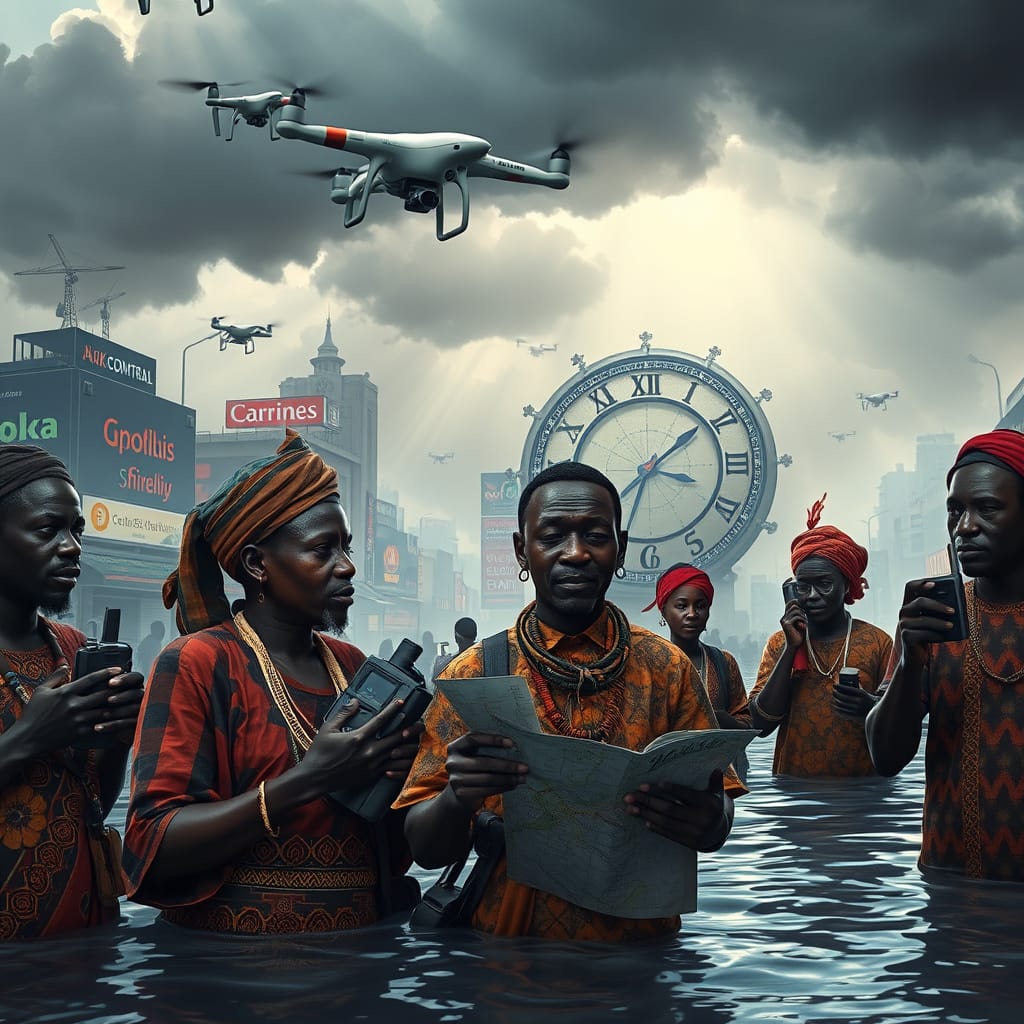In which we examine the curious case of a country that can monitor oil pipelines with drones but apparently cannot predict when rivers might overflow
It was a truth universally acknowledged that Nigeria, a nation possessed of considerable technological prowess, must be in want of applying said prowess to the preservation of human life. Yet as the flash floodwaters rose across the country recently, claiming 200 lives and leaving 500 missing, one could not help but observe a most peculiar phenomenon: a digital economy that had mastered the art of cryptocurrency transactions and fintech innovations had somehow failed to master the considerably simpler challenge of water level monitoring!
The irony was not lost on those who had witnessed Nigeria’s remarkable technological ascension over the preceding decade. Here was a nation that had birthed unicorn startups, developed sophisticated blockchain applications, and deployed advanced drone technology to monitor thousands of kilometers of oil infrastructure. Yet when nature presented its annual hydrological examination, the country appeared to have forgotten that the same sensors monitoring crude oil flow could theoretically be repurposed to detect rising water levels in flood-prone areas.
The Great Technological Amnesia: When Innovation Meets Inaction
The phenomenon observed in Nigeria represents what technology analysts have begun terming “selective digital competence“—the curious ability of a society to develop cutting-edge solutions for profitable problems while maintaining a studied ignorance of life-threatening challenges that offer less obvious monetization opportunities. It is as if the nation’s considerable technical expertise had been afflicted with a peculiar form of amnesia, remembering how to build payment processing systems but forgetting how to build early warning networks.
Consider the technological infrastructure already in place across Nigeria. The country’s oil and gas sector employs sophisticated monitoring systems capable of detecting minute pressure changes in pipelines spanning thousands of kilometers. These systems utilize advanced sensor networks, satellite communications, and real-time data analytics to prevent environmental disasters and protect valuable petroleum assets. The same fundamental technologies—sensors, communication networks, and data processing capabilities—could theoretically be deployed to monitor river levels, rainfall patterns, and flood conditions with minimal adaptation.
Yet as communities across Nigeria found themselves inundated with floodwaters, the nation’s impressive technological capabilities seemed to evaporate like the morning mist in Timbuktu. The drones that routinely inspect oil infrastructure remained conspicuously absent from search and rescue operations. The data analytics platforms that optimize financial transactions showed no evidence of being repurposed for flood prediction modeling. The mobile networks that facilitate millions of digital payments daily carried no automated flood warnings to vulnerable communities.
The Fintech Paradox: Optimizing Transactions While Ignoring Tragedy
Nigeria’s fintech sector represents one of Africa’s greatest technological success stories, processing billions of dollars in transactions through increasingly sophisticated platforms. These systems demonstrate remarkable capabilities in real-time data processing, risk assessment, and automated decision-making. The algorithms that determine creditworthiness can analyze thousands of data points in milliseconds, yet apparently no similar systems exist to analyze meteorological data and predict flood risks.
The contrast is particularly stark when one considers the infrastructure requirements. A flood monitoring system requires sensors to detect water levels, communication networks to transmit data, and processing capabilities to analyze patterns and generate alerts. A fintech platform requires sensors to detect transaction attempts, communication networks to transmit payment data, and processing capabilities to analyze risk patterns and approve or decline transactions. The technological foundations are virtually identical; only the application differs.
This suggests that Nigeria’s technological capabilities are not constrained by technical limitations but by economic incentives. Fintech platforms generate revenue with every transaction processed, creating clear business models that justify investment in sophisticated infrastructure. Flood monitoring systems, by contrast, generate no immediate revenue stream, making them less attractive to private investment despite their obvious social value.
The Drone Deployment Dilemma: Selective Surveillance Syndrome
Perhaps no aspect of Nigeria’s technological paradox is more glaring than the deployment patterns of its drone capabilities. The country has demonstrated remarkable proficiency in utilizing unmanned aerial vehicles for industrial applications, particularly in monitoring oil pipeline infrastructure across challenging terrain. These operations require sophisticated flight planning, real-time video transmission, data analysis capabilities, and coordination with ground-based response teams.
Yet when floods struck and hundreds of people went missing, these same drone capabilities seemed to vanish into bureaucratic ether. The aircraft that can navigate complex flight paths to inspect remote pipeline sections apparently could not be redirected to search for stranded flood victims. The real-time video systems that detect pipeline damage could not be repurposed to locate people trapped by rising waters. The coordination systems that manage industrial monitoring operations showed no evidence of being adapted for humanitarian search and rescue missions.
This selective deployment of technological capabilities reveals a troubling pattern in how societies prioritize the application of their technical resources. Infrastructure that protects economic assets receives sophisticated technological protection, while infrastructure that protects human lives relies on considerably more primitive approaches. It is as if the nation had developed a form of technological tunnel vision, capable of seeing oil leaks with remarkable clarity while remaining blind to human suffering.
The Data Analytics Blind Spot: Predicting Profits but Not Precipitation
Nigeria’s growing reputation as a hub for data analytics and artificial intelligence makes the absence of flood prediction systems even more perplexing. The country hosts numerous startups and established companies specializing in data analysis, machine learning, and predictive modeling. These organizations routinely process vast datasets to identify market trends, optimize supply chains, and predict consumer behavior with impressive accuracy.
The meteorological and hydrological data required for flood prediction is considerably more structured and predictable than the market data these systems typically analyze. Rainfall patterns, river flow rates, and seasonal flooding trends follow physical laws that are far more consistent than human economic behavior. The sensors required to collect this data are less expensive and more reliable than the market data feeds that power financial analytics platforms.
Yet despite having both the technical expertise and the data infrastructure necessary for sophisticated flood prediction, Nigeria appears to have made no significant investment in applying these capabilities to disaster prevention. The algorithms that can predict which customers are likely to default on loans apparently cannot be adapted to predict which communities are likely to experience flooding. The machine learning models that optimize advertising targeting show no evidence of being repurposed for optimizing emergency response deployment.
The Infrastructure Inversion: Building Backwards from Profit
The Nigerian flood crisis illustrates a broader phenomenon in technological development: the tendency for societies to build sophisticated solutions for profitable problems while neglecting basic applications that could save lives. This represents a fundamental inversion of technological priorities, where complexity is pursued for commercial gain while simplicity is ignored for humanitarian need.
Flood defense systems represent some of the oldest and most proven applications of engineering technology. From ancient levee systems to modern pumping stations, human societies have developed increasingly sophisticated methods for managing water flow and protecting communities from flooding. These systems require no breakthrough innovations or cutting-edge research—they simply require the application of well-established engineering principles and adequate investment in infrastructure.
Yet Nigeria, despite its demonstrated technological capabilities, appears to have invested minimal resources in these proven flood defense technologies. The same engineering expertise that designs complex oil extraction facilities could easily be applied to designing flood control systems. The project management capabilities that coordinate major infrastructure developments could be redirected toward building comprehensive flood defenses. The financial resources that fund technological innovation could be partially allocated to implementing basic flood protection measures.
The Humanitarian Technology Gap: When Innovation Ignores Impact
The disconnect between Nigeria’s technological capabilities and its flood response reveals a fundamental gap in how societies conceptualize the relationship between tech innovation and humanitarian impact. The country’s tech sector has achieved remarkable success in developing solutions that generate economic value, yet has shown little interest in developing solutions that preserve human life.
This gap reflects broader patterns in global technology development, where market incentives drive innovation toward profitable applications while humanitarian needs remain underserved. The venture capital funding that fuels fintech development rarely flows toward flood prediction systems. The talent that builds cryptocurrency platforms seldom applies their skills to disaster prevention. The infrastructure that supports digital commerce shows little overlap with the infrastructure needed for emergency response.
The result is a technological ecosystem that can process millions of financial transactions per second but cannot provide timely flood warnings to vulnerable communities. A digital economy that can track cryptocurrency portfolios in real-time but cannot track rising water levels in flood-prone areas. An innovation sector that can optimize supply chain logistics but cannot optimize emergency evacuation procedures.
The Moral Algorithm: Calculating the Cost of Technological Neglect
As the death toll from Nigeria’s floods reached a tragic 200 with 500 still missing, the true cost of the country’s selective technological application became tragically clear. Each life lost represents not just a human tragedy but a failure of technological imagination—an inability to envision how existing capabilities could be repurposed for humanitarian benefit.
The sensors monitoring oil pipelines could have been monitoring water levels. The drones inspecting industrial infrastructure could have been conducting search and rescue operations. The data analytics platforms optimizing financial transactions could have been predicting flood risks and coordinating emergency responses. The communication networks facilitating digital payments could have been broadcasting early warnings to threatened communities.
The technology existed. The expertise existed. The infrastructure existed. What was missing was the institutional will to apply these capabilities to the preservation of human life rather than the protection of economic assets. Nigeria’s flood crisis thus represents not a technological failure but a moral one—a collective decision to prioritize profit over people in the allocation of technological resources.
The Innovation Imperative: Redirecting Technical Talent Toward Human Need
The Nigerian flood tragedy offers a sobering reminder that technological capability without humanitarian application represents a profound waste of human potential. The country’s impressive tech sector achievements demonstrate that it possesses the technical talent, infrastructure, and resources necessary to address complex challenges. The question is whether these capabilities will be directed toward solving problems that matter for human welfare or remain focused exclusively on opportunities that generate economic returns.
The path forward requires no technological breakthroughs or revolutionary innovations. It simply requires the recognition that the same technical principles underlying profitable applications can be applied to life-saving purposes. Flood prediction systems use the same sensor technologies as pipeline monitoring. Emergency communication networks use the same infrastructure as payment processing systems. Search and rescue coordination employs the same logistics optimization as supply chain management.
What is needed is a fundamental reorientation of technological priorities—a recognition that the highest application of human ingenuity is not the optimization of profit margins but the preservation of human life. Nigeria’s tech sector has proven its capabilities in the commercial realm. The Nigeria flash flood crisis demonstrates the urgent need to apply those same capabilities to humanitarian challenges.
The choice facing Nigeria’s technological community is clear: continue building systems that optimize economic transactions while people drown in predictable floods, or redirect some portion of their considerable talents toward ensuring that such preventable tragedies never occur again. The technology exists to save lives. The only question is whether the will exists to use it.
What’s your take on this technological paradox? Have you noticed similar patterns in your own country or industry—sophisticated tech for profit-driven applications while basic humanitarian needs go unaddressed? Do you think market incentives are fundamentally incompatible with life-saving technology development, or could there be business models that align profit with humanitarian impact? Share your thoughts on how we might better direct our technological capabilities toward preventing such preventable tragedies.
Enjoyed this dose of uncomfortable truth? This article is just one layer of the onion.
My new book, “The Subtle Art of Not Giving a Prompt,” is the definitive survival manual for the AI age. It’s a guide to thriving in a world of intelligent machines by first admitting everything you fear is wrong (and probably your fault).
If you want to stop panicking about AI and start using it as a tool for your own liberation, this is the book you need.
>> Get your copy now (eBook & Paperback available) <<





GIPHY App Key not set. Please check settings